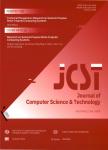A Cluster Based Feature Selection Method for Cross-Project Software Defect Prediction
A Cluster Based Feature Selection Method for Cross-Project Software Defect Prediction作者机构:State Key Laboratory for Novel Software Technology Nanjing University Nanjing 210023 China School of Computer Science and Technology Nantong University Nantong 226019 China
出 版 物:《Journal of Computer Science & Technology》 (计算机科学技术学报(英文版))
年 卷 期:2017年第32卷第6期
页 面:1090-1107页
核心收录:
学科分类:12[管理学] 1201[管理学-管理科学与工程(可授管理学、工学学位)] 0808[工学-电气工程] 08[工学] 0835[工学-软件工程] 0701[理学-数学] 0811[工学-控制科学与工程] 0812[工学-计算机科学与技术(可授工学、理学学位)]
基 金:国家自然科学基金 the Collaborative Innovation Center of Novel Software Technology and Industrialization the Open Project of State Key Laboratory for Novel Software Technology at Nanjing University 国家973计划
主 题:software defect prediction cross-project defect prediction feature selection feature clustering density-basedclustering
摘 要:Cross-project defect prediction (CPDP) uses the labeled data from external source software projects to com- pensate the shortage of useful data in the target project, in order to build a meaningful classification model. However, the distribution gap between software features extracted from the source and the target projects may be too large to make the mixed data useful for training. In this paper, we propose a cluster-based novel method FeSCH (Feature Selection Using Clusters of Hybrid-Data) to alleviate the distribution differences by feature selection. FeSCH includes two phases. Tile feature clustering phase clusters features using a density-based clustering method, and the feature selection phase selects features from each cluster using a ranking strategy. For CPDP, we design three different heuristic ranking strategies in the second phase. To investigate the prediction performance of FeSCH, we design experiments based on real-world software projects, and study the effects of design options in FeSCH (such as ranking strategy, feature selection ratio, and classifiers). The experimental results prove the effectiveness of FeSCH. Firstly, compared with the state-of-the-art baseline methods, FeSCH achieves better performance and its performance is less affected by the classifiers used. Secondly, FeSCH enhances the performance by effectively selecting features across feature categories, and provides guidelines for selecting useful features for defect prediction.



